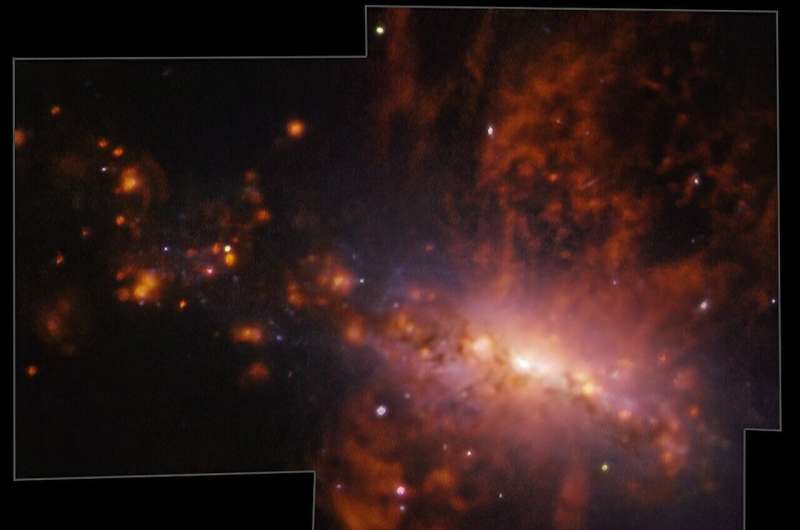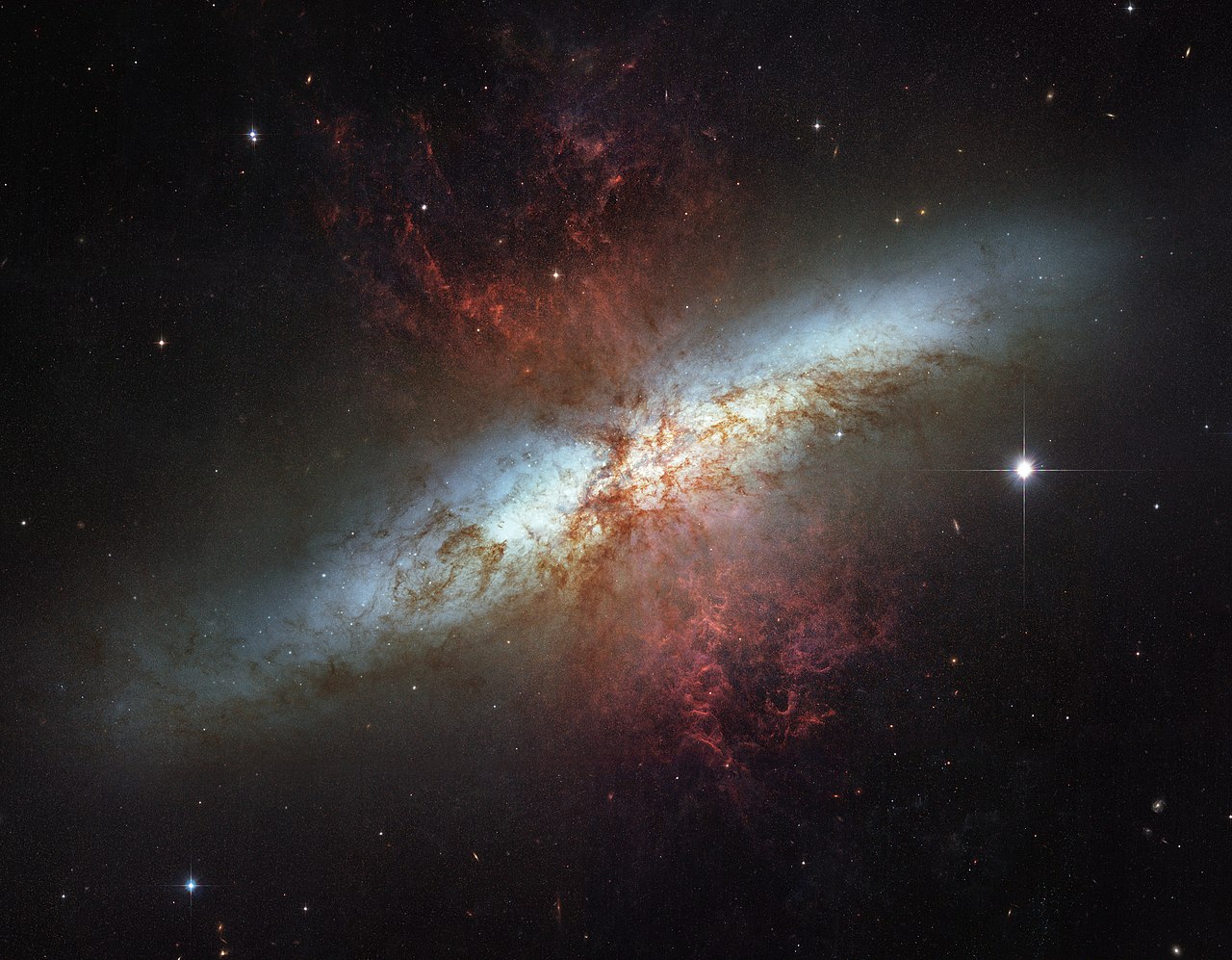AVAO wrote: ↑Sat Apr 13, 2024 3:50 am MAUVE survey: Giant galactic explosion in NGC 4383 exposes galaxy pollution in action
phys.org | 2024 April 21
TY4YA JacA team of international researchers studied galaxy NGC 4383, in the nearby Virgo cluster, revealing a gas outflow so large that it would take 20,000 years for light to travel from one side to the other. [...] Lead author Dr. Adam Watts, from The University of Western Australia node at the International Centre for Radio Astronomy Research (ICRAR), said the outflow was the result of powerful stellar explosions in the central regions of the galaxy that could eject enormous amounts of hydrogen and heavier elements.
[...]
The survey used the MUSE Integral Field Spectrograph on the European Southern Observatoryʼs Very Large Telescope, located in northern Chile. "NGC 4383 was our first target, as we suspected something very interesting was happening, but the data exceeded all our expectations. "We hope that in the future, MAUVE observations reveal the importance of gas outflows in the local universe with exquisite detail."
[...]
more
MAUVE survey: Giant galactic explosion in NGC 4383
- AVAO
- Commander
- Posts: 787
- Joined: Tue May 28, 2019 12:24 pm
- AKA: multiwavelength traveller
- Location: Zurich, Switzerland
MAUVE survey: Giant galactic explosion in NGC 4383
Re: MAUVE survey: Giant galactic explosion in NGC 4383
AVAO wrote: ↑Mon Apr 22, 2024 7:16 pmAVAO wrote: ↑Sat Apr 13, 2024 3:50 am MAUVE survey: Giant galactic explosion in NGC 4383 exposes galaxy pollution in action
phys.org | 2024 April 21
TY4YA JacA team of international researchers studied galaxy NGC 4383, in the nearby Virgo cluster, revealing a gas outflow so large that it would take 20,000 years for light to travel from one side to the other. [...] Lead author Dr. Adam Watts, from The University of Western Australia node at the International Centre for Radio Astronomy Research (ICRAR), said the outflow was the result of powerful stellar explosions in the central regions of the galaxy that could eject enormous amounts of hydrogen and heavier elements.
[...]
The survey used the MUSE Integral Field Spectrograph on the European Southern Observatoryʼs Very Large Telescope, located in northern Chile. "NGC 4383 was our first target, as we suspected something very interesting was happening, but the data exceeded all our expectations. "We hope that in the future, MAUVE observations reveal the importance of gas outflows in the local universe with exquisite detail."
[...]
more
I disagree! The star formation-driven gas outflow from NGC 4383 is not unique. The outflow of M82 is also produced by a violent starburst!Phys.org wrote about NGC 4383:
Galaxy NGC 4383 evolving strangely. Gas is flowing from its core at a rate of over 200 km/s. This mysterious gas eruption has a unique cause: star formation.
An interesting difference between NGC 4383 and M82 is that M82 is a galaxy with red colors in optical light. Its B-V index is 0.89, which is red, and its U-B index is 0.31, which is also red. Almost certainly the red colors are due to heavy dust reddening.
NGC 4383 is much bluer: Its B-V index is 0.55, which is blue, and its U-B index is —0.26, which is indeed blue. Almost certainly NGC 4383 is less dust-reddened than M82, although it really is reddened. NGC 4383 is two magnitudes brighter in the far infrared than at B magnitude, which is a lot, but M82 is almost four magnitudes brighter in the far infrared than at B wavelengths, which a lot indeed!
Another difference is that the starburst in M82 is concentrated in a small region in the core, whereas the starburst in M83 seems to be "elongated". In fact, it seems to have spread laterally almost like wildfire!
Note the long dusty bar stretching up and to the left in the picture of NGC 4383. Note the blue outflow at the end of the bar. It could be that the starburst is progressing throughout the bar, although, admittedly, a full-blown starburst in the bar would wreak havoc with the bar, and not leave it so long and straight!
Interestingly, there is one more similarity between NGC 4383 and M82. Their starbursts seem to have "killed" star formation in their disks. The small blurry picture of NGC 4383 shows a large yellow halo surrounding a long dusty bar and a blue-white center, whereas the disk of M82 shows chaotic dust but no regions of star formation. The center of M82 is hidden behind dust.
Ann
Color Commentator
- AVAO
- Commander
- Posts: 787
- Joined: Tue May 28, 2019 12:24 pm
- AKA: multiwavelength traveller
- Location: Zurich, Switzerland
Re: MAUVE survey: Giant galactic explosion in NGC 4383
Ann wrote: ↑Tue Apr 23, 2024 5:40 amI disagree! The star formation-driven gas outflow from NGC 4383 is not unique. The outflow of M82 is also produced by a violent starburst!Phys.org wrote about NGC 4383:
Galaxy NGC 4383 evolving strangely. Gas is flowing from its core at a rate of over 200 km/s. This mysterious gas eruption has a unique cause: star formation.
An interesting difference between NGC 4383 and M82 is that M82 is a galaxy with red colors in optical light. Its B-V index is 0.89, which is red, and its U-B index is 0.31, which is also red. Almost certainly the red colors are due to heavy dust reddening.
NGC 4383 is much bluer: Its B-V index is 0.55, which is blue, and its U-B index is —0.26, which is indeed blue. Almost certainly NGC 4383 is less dust-reddened than M82, although it really is reddened. NGC 4383 is two magnitudes brighter in the far infrared than at B magnitude, which is a lot, but M82 is almost four magnitudes brighter in the far infrared than at B wavelengths, which a lot indeed!
Another difference is that the starburst in M82 is concentrated in a small region in the core, whereas the starburst in M83 seems to be "elongated". In fact, it seems to have spread laterally almost like wildfire!Admittedly though, it might just be the star formation that is spreading laterally, not the gaseous outflow. The outflow does seem to be concentrated in the center.
Note the long dusty bar stretching up and to the left in the picture of NGC 4383. Note the blue outflow at the end of the bar. It could be that the starburst is progressing throughout the bar, although, admittedly, a full-blown starburst in the bar would wreak havoc with the bar, and not leave it so long and straight!
Interestingly, there is one more similarity between NGC 4383 and M82. Their starbursts seem to have "killed" star formation in their disks. The small blurry picture of NGC 4383 shows a large yellow halo surrounding a long dusty bar and a blue-white center, whereas the disk of M82 shows chaotic dust but no regions of star formation. The center of M82 is hidden behind dust.
Ann
ThanX Ann
Great comments!
Jac
jac berne (flickr)



